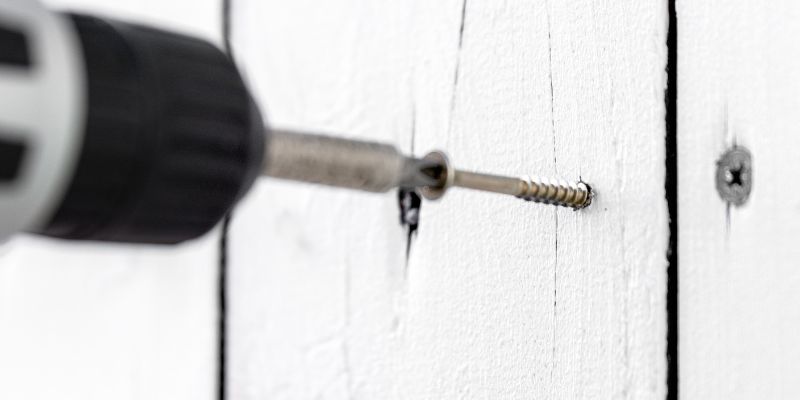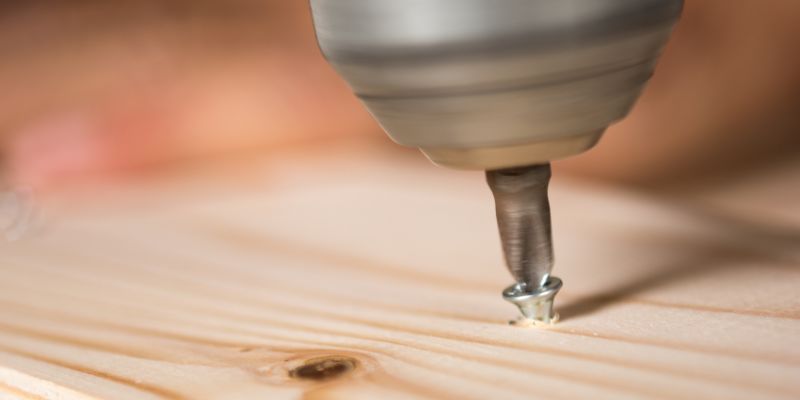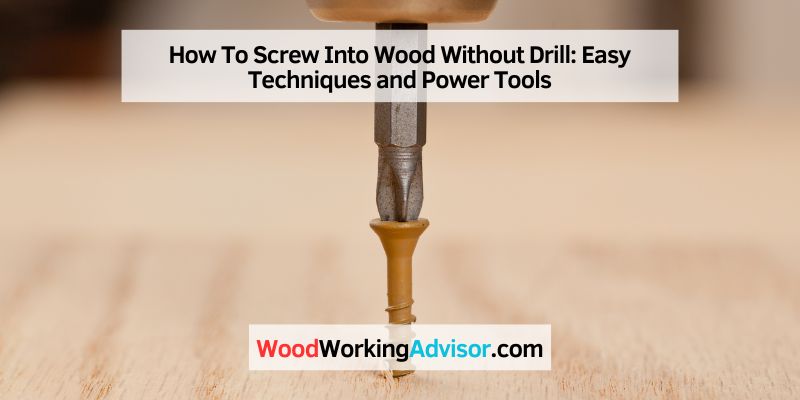To screw into wood without a drill, use a screwdriver and apply firm pressure and a twisting motion while turning the screw into the wood. Now, let’s explore some simple yet effective methods for screwing into wood without a drill.
When you find yourself in a situation where you need to secure something to a piece of wood but don’t have a drill on hand, it can be frustrating. However, there are alternative methods to achieve this. By following a few simple steps, you can easily screw into wood without a drill.
Whether it’s a small DIY project or a quick fix, these methods will come in handy. We will discuss various techniques and tools that you can use to screw into wood without the need for a drill.
1. Preparing The Wood Surface
Before you start screwing into wood without a drill, it’s crucial to properly prepare the wood surface. This step ensures that the screws go in smoothly and securely. There are two essential tasks to complete in order to ensure optimal results:
1.1 Cleaning The Wood
To begin, ensure that the wood surface is clean and free from any dust, dirt, or debris. Cleaning the wood is necessary to create a smooth and even surface for the screws to grip onto. Here’s a simple process to follow when cleaning the wood:
- Wipe the wood surface with a clean, dry cloth to remove any loose particles.
- If there are stubborn stains or grime, use a mild soap or wood cleaner diluted in water and gently scrub the surface with a soft-bristle brush.
- Thoroughly rinse the wood with clean water to remove any residue from the cleaner.
- Dry the wood surface completely before proceeding to the next step.

1.2 Sanding The Wood
After cleaning the wood, it’s time to sand the surface. Sanding ensures that the wood is smooth and free from any rough areas that could hinder the screw’s grip. Follow these steps to properly sand the wood:
- Start by selecting the appropriate grit sandpaper based on the condition of the wood surface. Finer grits (such as 120 or 220) are ideal for smooth surfaces, while rougher grits (around 80) work well for more rugged wood.
- Wrap the sandpaper around a sanding block or use a sanding sponge for better control.
- With even pressure, sand the wood surface in the direction of the wood grain. This technique helps to prevent any damage or splintering of the wood.
- Continue sanding until the surface feels smooth and any imperfections have been removed.
- After sanding, wipe away any dust with a clean, dry cloth to ensure a clean surface for screwing in.
By following these steps and properly preparing the wood surface, you can confidently proceed to screw into the wood without a drill. Make sure to use the appropriate screws for your project and exert enough pressure to ensure a secure fit. With a little patience and attention to detail, you’ll be able to accomplish your task effectively.
2. Techniques For Screwing Into Wood Without A Drill
When you find yourself in a situation where you need to screw into the wood but don’t have a drill, there are several effective techniques you can use. These methods can come in handy if you don’t own a drill, or if you need a quick solution on the go. In this section, we will explore three techniques for screwing into wood without a drill.
2.1 Using A Screwdriver
A screwdriver is a versatile tool that can be used for more than just turning screws. When it comes to screwing into wood without a drill, a screwdriver can be your best friend. Here’s how you can do it:
- Start by making a small pilot hole in the wood using a nail. This will help guide the screw and prevent the wood from splitting.
- Choose a screwdriver that matches the head of the screw. It’s important to use the right size to ensure a snug fit and prevent slippage.
- Hold the screw firmly with one hand and position the screwdriver over the screw head.
- Apply downward pressure while turning the screwdriver clockwise to drive the screw into the wood.
- Continue turning the screwdriver until the screw is fully embedded into the wood, making sure it is flush with the surface.
2.2 Using A Hammer And Nail
If you don’t have a screwdriver handy, another technique you can use is a hammer and nail. Here’s how:
- Start by making a small pilot hole in the wood using a nail. This will create a guide for the screw.
- Choose a screw that matches the size of the hole you have made. The screw should have a pointed end, similar to a nail.
- Hold the screw by its head and position it over the pilot hole.
- Tap the screw gently with a hammer, driving it into the wood. Make sure to keep the screw straight and apply consistent pressure.
- Continue tapping the screw until it is fully embedded in the wood, ensuring it is flush with the surface.
2.3 Using A Screw Extractor
If you have a stuck or stripped screw that needs to be removed, you can use a screw extractor to get the job done. Here’s how:
- Select a screw extractor that matches the size of the screw you want to remove. Screw extractors typically come in sets with different sizes.
- Insert the tip of the screw extractor into the head of the stuck screw.
- Hold the screw extractor firmly and turn it counterclockwise using a wrench or pliers. The extractor will create a grip inside the screw head and start loosening it.
- Continue turning the screw extractor counterclockwise until the screw is fully removed from the wood.
3. Power Tools For Screwing Into Wood Without A Drill
When it comes to working with wood, having the right tools can make all the difference. While using a drill is the most common method for screwing into wood, there are situations where using power tools without a drill can be useful. In this section, we will explore two power tools that can effectively screw into wood without the need for a drill: impact drivers and screw guns.
3.1 Impact Drivers
Impact drivers are compact and powerful tools that are designed to provide high torque for driving screws into various materials, including wood. They utilize a combination of rotational force and concussive blows to easily insert screws without the need for a separate drill. The impact action helps to prevent the driver bit from slipping or stripping the screw head.
Impact drivers are lightweight and easy to handle, making them a popular choice for both professionals and DIY enthusiasts. They typically have adjustable speed settings to match the requirements of different wood projects. Whether you’re building furniture or installing shelves, an impact driver can help you screw into wood quickly and efficiently.
With an impact driver, you can:
- Drive screws effortlessly into wood
- Handle large projects with ease
- Minimize the risk of stripped screw heads
- Adjust the speed according to the wood type and screw size
3.2 Screw Guns
Screw guns are specialized power tools that are designed specifically for driving screws into various materials, including wood. These tools are often used in professional woodworking and construction projects where speed and efficiency are important.
Screw guns feature a high torque output and come with a depth adjustment mechanism, allowing you to set the desired screw depth without the need for additional tools. Some models even have a collated screw system, which automatically feeds screws for faster and continuous screwing into wood.
With a screw gun, you can:
- Drive screws quickly and efficiently
- Set the desired screw depth easily
- Work on large-scale projects with speed
- Utilize the collated screw system for enhanced productivity
Both impact drivers and screw guns can be excellent alternatives to traditional drills when it comes to screwing into wood. They provide the power and efficiency required to tackle various wood projects without compromising on precision and accuracy. Choose the tool that best suits your needs and get ready to tackle your next woodworking project with ease!
4. Tips And Tricks For Successful Screw Insertion
When it comes to screwing into wood without a drill, there are a few tips and tricks that can make the process easier and more successful. Whether you’re a beginner or an experienced DIYer, these techniques will help you achieve a secure and reliable connection. In this section, we’ll explore four important factors to consider when screwing into wood without a drill.
4.1 Selecting The Right Screw
Choosing the correct screw for your project is crucial for successful screw insertion. You’ll want to consider factors such as the length and gauge of the screw, as well as the type of wood you’re working with.
Table: Types of Wood and Corresponding Screw Type
| Wood Type | Suggested Screw Type |
|---|---|
| Softwood (pine, cedar) | Coarse-threaded screw |
| Hardwood (oak, maple) | Fine-threaded screw |
To ensure a secure connection, make sure the diameter of the screw matches the size of the pilot hole (if using one). Additionally, opt for a screw with a sharp point, as this will help it penetrate the wood more easily.
4.2 Using Pilot Holes
Using pilot holes can greatly improve your chances of successful screw insertion. A pilot hole is a small hole drilled into the wood before inserting the screw. This creates a path for the screw to follow, reducing the risk of splitting the wood.
- Prevents wood from splitting
- Guides the screw smoothly into place
- Reduces the amount of force needed
When creating a pilot hole, ensure its diameter is slightly smaller than the core diameter of the screw. This will provide enough grip while still allowing the screw to penetrate the wood easily.
4.3 Applying Proper Pressure
Applying the right amount of pressure when screwing into wood is essential. Too much pressure can cause the screw to strip the wood or break, while too little pressure may result in a loose connection.
- Start with a firm grip on the screwdriver or screwdriver bit.
- Apply downward force as you turn the screw clockwise.
- Monitor the resistance to gauge if you’re using sufficient pressure.
Remember, it’s important to strike a balance between applying enough pressure to ensure a secure connection, without overexerting force and causing damage.
4.4 Using Lubrication
Using lubrication can make the process of screwing into wood without a drill much smoother. Lubricating the screw before insertion reduces friction, allowing the screw to glide into place effortlessly.
Before applying any lubricant, ensure it’s compatible with the type of wood and won’t cause any staining or damage. An effective lubricant can be something as simple as soap or wax.
By following these tips and tricks, you can ensure successful screw insertion when working with wood, even without a drill. Remember to select the right screw, consider using pilot holes, apply proper pressure, and use lubrication for smoother insertion.
5. Safety Precautions
When it comes to screwing into wood without a drill, it’s important to take safety precautions. By following these guidelines, you can ensure a secure and stable installation without the need for power tools.
When it comes to screwing into wood without a drill, it is important to prioritize safety. By following a few key precautions, you can minimize the risk of accidents and injuries. In this section, we will discuss two crucial safety measures that you should keep in mind.
5.1 Wearing Protective Gear
Before you start screwing into wood, make sure to wear the necessary protective gear. This will help shield you from potential hazards and ensure your safety throughout the process. The following items are recommended:
|
|
By wearing the appropriate protective gear, you can reduce the chances of accidents and injuries while screwing into wood.

5.2 Securing The Wood
Another important safety precaution is to secure the wood properly before beginning the screwing process. Securing the wood will ensure that it remains stable and stationary, reducing the risk of slips or mishaps. Here are some steps to follow:
- Place the wood on a stable surface, such as a workbench or sawhorse.
- If necessary, clamp the wood securely to prevent it from moving during the screwing process.
- Ensure that the wood is properly supported and balanced to avoid any accidental falls.
- Double-check that the wood is free from any obstructions or debris that may interfere with the screwing process.
Securing the wood before screwing will provide a stable and safe working environment, ensuring that you can complete the task without any unnecessary risks.
Conclusion
Screwing into wood without a drill may seem impossible, but with a few clever techniques, it can be done. From using alternative tools like screwdrivers and pliers to pre-drilling pilot holes, these methods offer viable solutions for those without access to a drill.
By following these tips, you’ll be able to confidently tackle your wood projects with ease, even without a drill in hand. So go ahead, get creative, and screw into wood like a pro!


